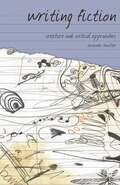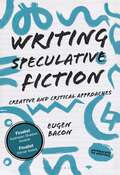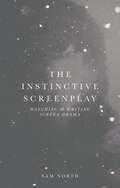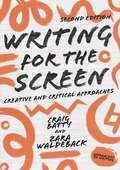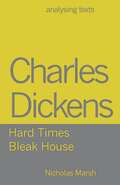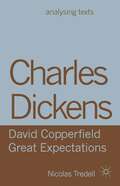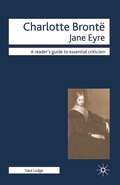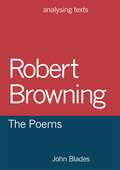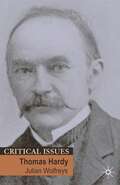- Table View
- List View
Story Logic and the Craft of Fiction
by Catherine BradyThis book illuminates how technique serves 'story logic,' the particular way fiction makes meaning. Writers raid the cupboard of theory looking for what works, and generic rules don't account for the rich variety of strategies they employ. For writers who are past the beginner stage, Brady offers a closer look at craft fundamentals, including plot, characterization, patterns of imagery, and style. The lively, lucid discussion draws on vivid examples from classic and contemporary fiction, ranging from George Eliot and William Faulkner to Haruki Murakami and Toni Morrison. Because it supplies the analytical tools needed to read as a writer, this text will enrich the reader's approach to any work of fiction, energizing discussion in a workshop or craft course.
The Creative Writing Handbook
by John Singleton and Mary LuckhurstThis revised and updated edition of The Creative Writing Handbook now includes new chapters on writing for stage and radio and on writing screenplays for film and television. Written by professional writers and tutors, it covers all aspects of the writing process, from drafting first thoughts to shaping them into polished and publishable work. In a series of lively and stimulating chapters, all major areas of writing are explored, from screen-writing to short fiction, from autobiography to experimental prose. The Handbook offers new and experienced writers a whole range of creative ideas, sound advice and open-ended tasks for exploring experience, mastering technique and thereby releasing the full potential of the imagination. As most taught courses in creative writing are in workshop form, each chapter includes invaluable ideas on how to run group sessions and offer a rich fund of suggestions for developing writing beyond the workshop.
The Desire to Write: The Five Keys to Creative Writing
by Graeme HarperIn this dynamic exploration of the discipline of creative writing, Graeme Harper departs from the established 'how-to' model in a personal manifesto which analyses why human beings are, and have long been, passionate about writing. Illuminating the five essential keys to creative writing, directly related to the desire to undertake it, Harper analyses creative writing's past and ponders its future, drawing on theories of the self, cultural interaction, consumption and communication. Blending practice-based critical context with contemporary creative writing theory, this book is an ideal companion for undergraduate and postgraduate students of creative writing and literature. Lively and thought-provoking, it is an invaluable tool for all aspiring and established writers who wish to harness the positive effects of their craft.
The Road to Somewhere: A Creative Writing Companion
by Robert Graham Helen Newall Heather LeachThis revised, updated and expanded new edition of The Road to Somewhere will help you to acquire the craft and disciplines needed to develop as a writer in today's world. It is ideal for anyone - student writers, writing teachers and seasoned authors - seeking practical guidance, new ideas and creative inspiration.The Road to Somewhere: A Creative Writing Companion, second edition offers:- New chapters on writing for digital media, flash fiction, memoir, style and taking your writing out into the world- updated chapters on fiction, scripts, poetry, and experimental forms- An examination of creative processes and advice on how to read as a writer - Many practical exercises and useable course materials- Extensive references and suggestions for further reading- Information on how to get work published or produced, in real and virtual worlds- Tips on how to set up and run writing workshops and groups- A complete Agony Aunt section to help with blocks and barriers- Guidance on the more technical aspects of writing such as layout and grammarAnd, to lighten your writing journey a little, we've tried to make this second edition even wittier and smarter than the first. So whether you see yourself as a published professional or a dedicated dabbler, this is the book to take along for the ride.
Writing Fiction: Creative and Critical Approaches (Approaches to Writing)
by Amanda BoulterExploring writing as a practice, Boulter draws from the work of writers and theorists to show how cultural and literary debates can help writers enhance their own fiction. Negotiating the creative-critical crossover, this is an approachable book that helps students develop practical writing skills and a critical awareness of creative possibilities.
Wordsmithery: The Writer's Craft and Practice
by Jayne SteelThis stimulating workbook is aimed at committed writers and students of creative writing who want to engage with ideas about writing and develop their craft and practice. Drawing on the expertise of a range of professional and award-winning contributors, the focus is on writing as 'process', moving from practical guidance on 'form and style' through to using themes such as 'body' or 'house' as a creative springboard. Including specially designed writing exercises and illustrative extracts, this innovative guide will inspire and challenge. It is an essential resource for anyone who wishes to master the art and practice of creative writing and galvanise their talent to professional and publication level.Contributions by: Linda Anderson, Theodore Deppe, George Green, Graeme Harper (aka Brooke Biaz), William Herbert, Lee Martin, Jenny Newman, Jayne Steel and a Foreword by Patricia Duncker.
Writing for Theatre: Creative and Critical Approaches (Approaches to Writing)
by Kim WiltshireWriting for theatre is a unique art form, different even from other kinds of scriptwriting. Making theatre is a truly collaborative process which can be a tricky aspect to grasp when starting out. This book will take you on a journey from the origins of theatre to what it means to write for the stage today. It includes a series of interviews with writers, directors and dramaturgs, all of whom are making theatre now, providing an unrivalled glimpse into the world of contemporary theatre making. Kim Wiltshire explores the foundations, traits and skills necessary for playwriting alongside the creative possibilities of writing theatre in the digital age. Each part of the book ends with a series of exercises which students of the craft can use to practise their art and stretch their creativity.
Writing Speculative Fiction: Creative and Critical Approaches (Approaches to Writing)
by Eugen BaconIn this engaging and accessible guide, Eugen Bacon explores writing speculative fiction as a creative practice, drawing from her own work, and the work of other writers and theorists, to interrogate its various subgenres. Through analysis of writers such as Stephen King, J.R.R. Tolkien and J. K. Rowling, this book scrutinises the characteristics of speculative fiction, considers the potential of writing cross genre and covers the challenges of targeting young adults. It connects critical and cultural theories to the practice of creative writing, examining how they might apply to the process of writing speculative fiction. Both practical and critical in its evaluative gaze, it also looks at e-publishing as a promising publishing medium for speculative fiction.This is essential reading for undergraduate and postgraduate students of creative writing, looking to develop a critical awareness of, and practical skills for, the writing of speculative fiction. It is also a valuable resource for creators, commentators and consumers of contemporary speculative fiction. Chapter 8, 'Horror and the Paranormal' was shortlisted for the Australasian Horror Writers Association (AHWA)'s 2019 Australian Shadows Awards.
The Instinctive Screenplay: Watching and Writing Screen Drama
by Sam NorthWhat is it that makes humans engage with a dramatic narrative? Is it linked to our primitive selves, contained within our instinctive experience?This innovative text argues that understanding how and why our human instincts are brought into play as we watch screen drama is the key to writing it. Analysing four powerful instincts – willpower, logic, morality and emotion – Sam North explores how they determine our level of involvement in their drama, and how screenwriters can use them to develop their craft. Including a variety of both well-known and less famous examples, from The Shawshank Redemption to Samira Makhmalbaf's The Apple, this book offers a fresh new approach to thinking about, discussing and writing screenplays.
Writing for the Screen: Creative and Critical Approaches
by Craig Batty Zara WaldebackThis revised and refreshed edition guides the contemporary screenwriter through a variety of creative and critical approaches to a deeper understanding of how to tell stories for the screen. With a renewed focus on theme and structure, the book is an essential guide for writers, script developers and teachers to help develop ideas into rich dynamic projects, and craft compelling, resonating screenplays. Combining creative tools and approaches with critical and contextual underpinnings, the book is ideal for screenwriting students who are looking to expand their skills and reflect on practices to add greater depth to their scripts. It will also inspire experienced writers and developers to find fresh ways of working and consider how new technology is affecting storytelling voices. Comprehensive and engaging, this book considers key narrative questions of today and offers a range of exercises to address them. Integrating creative guidance with rigorous scholarship, this is the perfect companion for undergraduate students taking courses in screenwriting. Encouraging and pragmatic, it will provide a wealth of inspiration for those wishing to work in the industry or deepen their study of the practice.New to this Edition:- Refreshed and revised edition to meet the demands of contemporary screenwriting- New case studies, models, tools and approaches to writing for the screen- Updated areas of industry practice, including web series, transmedia, VR and long-form storytelling- Includes practical approaches and creative exercises that can be used in the classroom
Charles Dickens - Hard Times/Bleak House (Analysing Texts)
by Nicholas MarshThis stimulating study takes a fresh look at two of Dickens' most widely-studied texts. Part I uses carefully selected short extracts for close textual analysis, while Part II examines the historical and literary contexts and key criticism. The volume is an ideal introductory guide for those who are studying Dickens' novels for the first time.
Charles Dickens: David Copperfield/ Great Expectations (Analysing Texts)
by Nicolas TredellDavid Copperfield and Great Expectations are among Charles Dickens's most famous novels. In both books, the hero tells the vivid and absorbing tale of his education by life, presents a rich range of characters and scenes, and tackles profound moral, social and psychological themes.Part I of this essential study:- Provides lucid and penetrating analyses of key passages- Discusses the crucial topics of patriarchy, class, obsession, eccentricity, death, breakdown and recovery- Summarizes the methods of analysis and offers suggestions for further workPart II supplies key background material, including:- An account of Dickens's life and works- A survey of historical, cultural and literary contexts- Samples of significant criticismAlso featuring a valuable Further Reading section, this volume provides readers with the critical and analytical skills which will enable them to enjoy and explore both novels for themselves.
Charlotte Bronte - Jane Eyre (Readers' Guides to Essential Criticism)
by Sara LodgeSara Lodge offers a lively introduction to the critical history of one of the most widely-studied nineteenth-century novels, from the first reviews through to present day responses. The Guide also includes sections devoted to feminist, Marxist and postcolonial criticism of Jane Eyre, as well as analysis of recent developments.
Eighteenth-Century Characters: A Guide to the Literature of the Age
by Elaine M. McGirrEighteenth-Century Characters offers a concise introduction to the eighteenth century, using characters as its starting point. Elaine M. McGirr presents contextualized readings of stock characters from canonical and popular literature, such as:- The rake and the fop- The country gentleman- The good woman- The coquette and the prude - The country maid and the town lady- The Catholic, the Protestant and the British Other.Each chapter explores how a character's significance and role changes over the century, illustrating and explaining radical shifts in taste, ideology and style. Also featuring illustrations, a Chronology and a helpful Bibliography and Further Reading section, this essential guide will provide students with the necessary background to understand the period's literature and to embark on further study.
George Eliot (Critical Issues)
by Pauline NestorGeorge Eliot was one of the great thinkers of her time, a figure central to the main currents of thought and belief in the nineteenth century. Yet when this distinguished public intellectual turned to fiction writing at the age of thirty-six, she regarded it not as a lesser pursuit, but as the distillation of all of her knowledge and ideas. For Eliot, fiction enabled the consideration of life 'in its highest complexity', and had the capacity not merely to elicit, but actually to create, moral sentiment by surprising readers into the recognition of realities other than their own.In this new study, Pauline Nestor offers a challenging reassessment of Eliot's contribution to the critical debates, both of her age and of her own era. In particular, she examines the author's literary expolration of ethics, especially in relation to the negotiation of difference. Nestor argues compellingly that, through a reading of their sophisticated drama of otherness, Eliot's novels can be seen as freshly relevant to contemporary theoretical debates in feminism, moral philosophy, post-colonial studies and psychoanalysis.Covering the writer's complete body of major fiction, this is an indispensable voume for anyone studying the work of one of the most important and influential novelists of the nineteenth century.
Gothic Fiction (Readers' Guides to Essential Criticism)
by Angela WrightWhat is the Gothic? Few literary genres have attracted so much praise and critical disdain simultaneously. This Guide returns to the Gothic novel's first wave of popularity, between 1764 and 1820, to explore and analyse the full range of contradictory responses that the Gothic evoked. Angela Wright appraises the key criticism surrounding the Gothic fiction of this period, from 18th century accounts to present-day commentaries. Adopting an easy-to-follow thematic approach, the Guide examines:- Contemporary criticism of the Gothic- The aesthetics of terror and horror - The influence of the French Revolution- Religion, nationalism and the Gothic- The relationship between psychoanalysis and the Gothic- The relationship between gender and the Gothic.Concise and authoritative, this indispensable Guide provides an overview of Gothic criticism and covers the work of a variety of well-known Gothic writers, such as Horace Walpole, Ann Radcliffe, Matthew Lewis and many others.
Jane Austen - Sense and Sensibility/ Pride and Prejudice/ Emma: A Comparative Longitudinal Study (Readers' Guides to Essential Criticism)
by Annika BautzThis Guide discusses the range of critical reactions to three of Jane Austen's most widely-studied and popular novels. Annika Bautz takes the reader chronologically through the profusion of criticism by selecting key approaches from the immense variety of responses these three Austen novels have provoked over the last two centuries.
Jane Austen: Northanger Abbey/Persuasion (Readers' Guides to Essential Criticism)
by Enit Karafili SteinerNorthanger Abbey was one of Jane Austen's earliest manuscripts; Persuasion was her last. Published together in a single volume after her death, the two books differ widely. Northanger Abbey is a spirited, Gothic parody, while Persuasion has increasingly been seen as a new direction for the Austen canon. The two texts have been widely analysed and debated since publication, and continue to be so today.In this Readers' Guide, Enit Karafili Steiner:- Delineates a clear trajectory through the books' many interpretations over two centuries, mapping these out thematically and chronologically.- Contextualises and brings into dialogue influential approaches such as psychoanalytical criticism, structuralism, deconstruction, Marxism, New Historicism, and feminism.- Discusses film adaptations of the novels and their relation to literary criticism.
Jonson: Volpone (Shakespeare Handbooks)
by Marshall BotvinickOne of the blackest comedies ever written, Ben Jonson's Volpone is the masterpiece of a playwright all too frequently dismissed for being unnecessarily dark and academic. Merciless in its depiction of avarice, this rich and masterful play provokes both laughter and indignation in its audiences.This Handbook:- Provides in-depth analysis of the play, scene by scene and line by line - Examines the multitude of interpretations of Volpone throughout history, including both on stage and screen- Explores the critical discourse surrounding the play and summarises the social and literary forces that shaped Jonson's work
Mary Shelley: Frankenstein (Analysing Texts)
by Nicholas MarshThis study focuses on how Frankenstein works: how the story is told and why it is so rich and gripping. Part I uses carefully selected short extracts for close textual analysis, while Part II examines Shelley's life, the historical and literary contexts of the novel, and offers a sample of key criticism.
Robert Browning: The Poems (Analysing Texts)
by John BladesThis stimulating study takes a fresh look at Browning's poetry and at some of the key themes that run through his work. Part I uses carefully selected extracts for close textual analysis, while Part II examines Browning's life, contexts and a sample of criticism. Using some of Browning's most widely studied poems, this book will develop students' close reading technique and help them to articulate their own responses to poetry.The volume is an ideal introductory guide for A Level and undergraduate English Literature students, or anyone studying Browning's poems for the first time.
Thomas Hardy (Critical Issues)
by Julian WolfreysNo other major author of the nineteenth century has arguably produced as much critical activity as Thomas Hardy. This timely addition to the Critical Issues series explores the various philosophical views of critics, with close textual analysis of Hardy's novels and with reference to his poetry.
Thomas Hardy - The Mayor of Casterbridge / Jude the Obscure (Readers' Guides to Essential Criticism)
by Simon AveryThis Reader's Guide analyses the critical history of two of Hardy's major tragic novels, from the time of their publication to the present. Simon Avery traces the changing critical fortunes of the texts and explores the diverse range of interpretations produced by different theoretical approaches.
Thomas Hardy: The Poems (Analysing Texts)
by Gillian SteinbergGillian Steinberg offers an approachable introduction to the poems of one of the most prolific and influential English writers, through an examination of wide-ranging selections from his work.Part I of this invaluable study:- Provides clear and stimulating close readings of Thomas Hardy's key poems- Considers major themes in Hardy's poetry, including ghosts, God's role in the world, war, and the painful passage of time- Summarizes the methods of analysis and provides suggestions for further workPart II supplies essential background material, featuring:- An account of Hardy's life and works- Samples of criticism from important Hardy scholarsWith a helpful Further Reading section, this insightful volume is ideal for anyone who wishes to appreciate and explore Hardy's poetry for themselves.
William Wordsworth - The Prelude (Readers' Guides to Essential Criticism)
by Tim MilnesThe Prelude is now seen as a central text in the Wordsworth corpus. This Guide identifies and gathers significant critical perspectives, interpretations and debates connected with the poem, contextualising and explaining criticism from the Victorian period right through to the present day.




